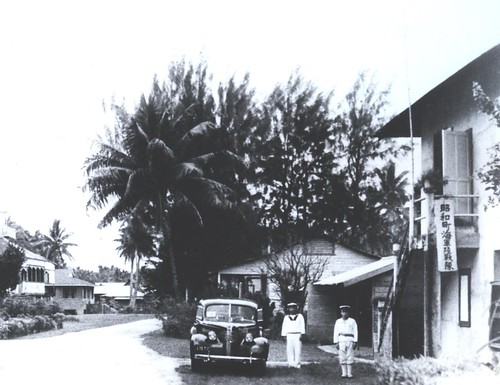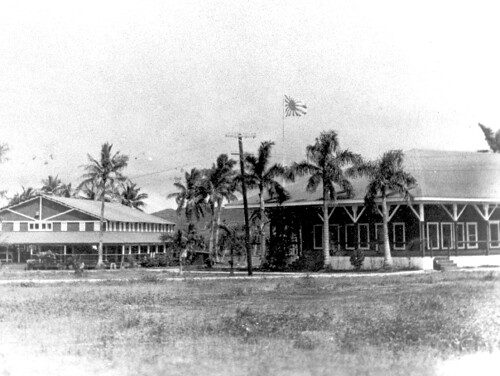Japanese Navy’s responsibility
The Japanese Navy was responsible for the administration of Guam after the occupation of the island on 10 December 1941. Japan’s basic military administration policies for its other occupied areas were also applied to Guam:
- Restoration of public order
- Attainment of economic self-sufficiency by combat troops
- Acquisition of major resources vital to national defense.
In order to achieve these goals along with the 23,000 CHamorus on the island, the Guam Minseibu (Department of Civil Administration) was established under the 5th Base Force based on Saipan in January 1942.
The Minseibu consisted of three small sections—general affairs, political affairs, and economic affairs—with nearly eighty civilian officers. The civil administration period can be divided into three sub-periods according to the Minseibu chiefs and island situations:
I. Commander Hayashi Hiromu’s period (January 1942 – June 1942): recovery of public peace.
II. Commander in the reserve Homura Teiichi period (June 1942 – October 1943): the most stable, but active Minseibu period.
III. Commander in the reserve Homura Teiichi period (November 1943 – March 1944): preparation for fortification and militarization of the island.
The three main areas of responsibility for the Minseibu were police affairs, Japanese language training, and CHamoru labor supply for industrial development of the island.
Because there were only a few islanders’ offenses and a relatively stable public order of the island after the Japanese occupation began, the primary work of the Minseibu police was to find six US military escapees. Five were found and executed by October 1942. The search for a single escapee, US Navy radioman George Tweed, continued for the entire 31 month period of Japanese rule. The police’s exhaustive investigation into Tweed’s whereabouts resulted in inhumane interrogations, including torture, of nearly one hundred CHamorus.
Schools open
The Minseibu gradually opened Japanese language schools for CHamoru children at the beginning of its administration. By early 1944, more than 3,800 students attended 19 schools and 41 attended the assistant teachers’ training school. Language training was not only for learning the Japanese language for communication between the ruled and the ruler, but also for teaching the CHamorus Japanese thought, culture, and particularly Japan’s main war purpose — the establishment of the Greater East Asia Co-prosperity Sphere.
As two of the three policies above indicate, Japan’s most important goal was Guam’s industrial development. The navy assigned Nan’yô Kôhatsu Kabushiki Kaisha, the South Seas Development Company, on Saipan to enforce rapid, aggressive, and intensive land development for rice, manganese mining, tropical agricultural products, forestry, fishing, and stock farming. The purpose of this development was to achieve Japan’s goals using local labor and methods because shortages of labor, material, or equipment in the homeland rendered subsidies from Japan impossible.
Turning point
The turning point for Japan’s occupation policy was October 1943 when the Naval Construction Battalion (Setsueitai) arrived on Guam to construct airfields at Orote Peninsula, Tiyan, and Finegayan. In addition to the Japanese Navy, the army’s 29th Division was dispatched from Manchuria to reinforce the Mariana Islands in February 1944. At about the same time, US air attacks and large scale Japanese defensive preparations began. The 54th Defense Guard Unit on Guam was renamed the 5th Naval Construction and Service Department Guam Sub-branch and was unified under the command of the 31st Army’s Mariana District Group.
The Minseibu was dissolved on 1 March 1944. These reorganizations meant that all CHamorus were placed directly under military control, and could be used for both the navy and the army’s labor forces as needed. They came under direct supervision of the Japanese military police, not of the civilian police.
Forced labor became a necessity since Japanese merchant ships were being sunk by American seacraft, particularly submarines, during the latter part of 1943 and throughout the first seven months of 1944. There were more than 18,000 Japanese troops in Guam by this time and recruiting all able-bodied men and women in Guam to work on the rice fields and plantations was an obvious necessity.
Beginning on 11 July 1944, about 15,000 CHamorus were evacuated to a coconut grove at the upper reaches of the Ylig River, Manenggon, Yona, some dying or killed along the way. The massive US invasion and fierce battle between the US and the Japanese militarism ended in early August 1944.
There is no official report on war damages suffered by the CHamorus, though there are many oral histories. According to the Guam Meritorious Claims Act written on November 1945, however, 795 war-connected claims were made by over 4,000 claimants. This included 320 deaths, 258 injuries, and 217 cases of property damage.
For further reading
Higuchi, Wakako. Remembering the War Years on Guam: A Japanese Perspective. Submitted to the War in the Pacific National Historical Park, National Park Service, Guam. Mangilao: University of Guam, 2001.
––– “The Japanisation Policy for the Chamorros of Guam, 1941-1944.” Journal of Pacific History 36, no.1 (June 2001): 19-35.
––– “A U.S. Territory in Japan’s South Sea Islands: The Japanese Navy Administration of Guam.” PhD diss., Australian National University, 2006.
Palomo, Tony. An Island in Agony. Self-published, 1984.
Sanchez, Pedro C. Guahan Guam: The History of Our Island. Hagåtña: Sanchez Publishing House, 1987.




